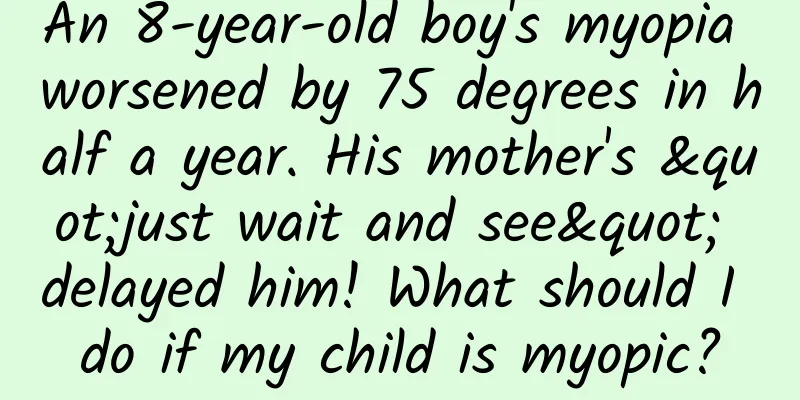An 8-year-old boy's myopia worsened by 75 degrees in half a year. His mother's "just wait and see" delayed him! What should I do if my child is myopic?

|
"My child is still young, and I don't want him to wear glasses" "Not high degree = pseudomyopia" "The more you wear glasses, the faster your myopia worsens" … In outpatient clinics, we often encounter parents who have such misunderstandings about myopia. Not only do they fail to help their children alleviate the development of myopia, but they also delay the intervention treatment of myopia. "Doctor Deng, Xiao Ming said that his vision is getting blurrier and blurrier. What should we do?" Xiao Ming's mother asked anxiously at the clinic of Chief Physician Deng Jun at the Optometry Center of Zhejiang Eye Hospital Zhijiang Branch. It turned out that Xiao Ming, who was 8 years old this year, had come to the hospital for a checkup half a year ago because he could not see the blackboard clearly in class. After the eye test, it was found that Xiao Ming's right eye was 75 degrees myopic and his left eye was 100 degrees myopic. Xiao Ming's mother said, how could a child so young be myopic? In order to further determine whether Xiao Ming was really myopic, Dr. Deng performed a mydriasis eye test on Xiao Ming, and the results showed that Xiao Ming was indeed myopic. Dr. Deng suggested that Xiao Ming's mother intervene in Xiao Ming's myopia to control the development of his myopia. However, Xiao Ming's mother said that the child was still young and could not take off his glasses. Moreover, he only had occasional problems seeing things clearly, but could see clearly most of the time. There was no need for him to wear glasses, and she hoped to observe for a while. Even though Dr. Deng repeatedly explained that wearing glasses would not cause myopia to worsen faster, it could not change Xiao Ming's mother's mind. She could only remind the parents to pay attention to letting their children use their eyes scientifically, do more outdoor activities, and come back for a check-up after 3 months. However, it was half a year later that Xiao Ming's mother brought Xiao Ming to Dr. Deng's clinic again. "Doctor Deng, I often find Xiao Ming squinting his eyes when watching TV. When I asked him, I found out that he can't see clearly anymore." After the eye test, it was found that Xiao Ming's myopia in both eyes had worsened to varying degrees, with the right eye myopia at 125 degrees and the left eye myopia at 175 degrees. Xiao Ming's mother regretted it very much: "Doctor Deng, I should have listened to you and brought Xiao Ming for a follow-up check-up every three months, so that his myopia would not have worsened so much all of a sudden. Doctor Deng, is there any good way to control it? It has increased by 75 degrees in half a year, which is terrible." In fact, many parents are at a loss as to what to do when they first discover their children are nearsighted. So, what is the right thing to do when you first discover your child is nearsighted? First, we need to confirm whether the child is really myopic. When parents find that their children squint to see things or cannot see the blackboard clearly, they can take their children to a professional ophthalmology hospital for an eye examination. In order to distinguish true from false myopia, mydriasis refraction can be performed, which can fully relax the ciliary muscles and remove accommodative spasms, making the eye examination results more reliable and objective, and more truly reflecting the child's refractive state. If the child's myopia degree does not change much (<0.5D) after mydriasis refraction, it means that the child is really myopic. Secondly, we need to find out the causes of myopia. Generally speaking, there are two categories: 1. Congenital genetic factors: Studies have shown that if parents are myopic, especially with high myopia, their children will have an increased chance of myopia. 2. Acquired environmental factors: ① Long-term use of the eyes, including reading books and watching electronic products at close range, which is also the main reason for the high incidence of myopia among children and adolescents in my country; ② Poor lighting conditions increase the burden on the eyes, leading to myopia; ③ Insufficient sleep time; ④ Too little outdoor exercise; ⑤ Poor reading and writing posture; ⑥ Improper diet, excessive intake of sugar and protein, etc. After discovering the cause of myopia, measures should be taken to control the development of myopia. At this time, some parents will ask, myopia is myopia, and you have to wear glasses anyway, it’s nothing more than a matter of degree, what is there to control? In fact, controlling myopia is very important, especially for children who are myopic at a young age. Because once myopia is not effectively controlled, it is easy to develop into high myopia (more than 600 degrees), and high myopia will bring a series of complications, some of which may even cause blindness. Common complications of high myopia include: retinal detachment, glaucoma, floaters, macular degeneration, cataracts, strabismus, amblyopia, etc. If a child is short-sighted at the age of eight, and if it is not controlled, the degree of myopia will increase rapidly, and the probability of high myopia is very high. Therefore, vigilance against high myopia should be started from an early age. In addition to improving daily eye habits and increasing outdoor activity time, it is also necessary to go to the hospital for a vision check in time. At present, there are three main methods to control the progression of myopia: 1. Orthokeratology lenses (OK lenses) OK lenses are a type of hard corneal contact lenses that are worn at night. When worn while sleeping, OK lenses can shape our cornea. When you take them off in the morning, you can still have clear vision even without wearing glasses. 2. Multi-point defocus soft contact lenses Multi-point defocus soft contact lenses are also a type of corneal contact lenses, but unlike OK lenses, multi-point defocus soft lenses need to be worn during the day. To the naked eye, their appearance is very similar to the contact lenses we adults wear. 3. Multi-point defocus frame glasses As the name suggests, the wearing method of multi-point defocus frame glasses is the same as that of traditional frame glasses, but defocus glasses need to be worn for a long time, generally requiring 12 hours of wearing, to achieve a good control effect. It should be made clear that no matter what control method is used, it cannot guarantee 100% effectiveness in controlling myopia, nor is it suitable for everyone. It requires a professional eye examination and a comprehensive evaluation by a doctor before a choice can be made. Parents also need to cooperate in regular hospital check-ups to monitor the progression of their children's myopia. Finally, after considering many aspects, Xiao Ming's mother asked Dr. Deng to fit Xiao Ming with OK glasses, hoping to control the progression of Xiao Ming's myopia. Metropolis Express·Chengshi Interactive Reporter Jin Jing Correspondent: Zhang Qingjie He Tingting |
<<: A woman died while taking care of her baby outdoors! Be careful about this in summer!
Recommend
Learn mathematical modeling and MATLAB programming in 7 days
Course Description This course requires a certain...
Recommendations for Zhaoqing mini program mall development, how to choose Zhaoqing mini program development company?
Mini programs are all developed by companies with...
There are so many ways to promote APP, let’s take a deep analysis of the points wall!
At 2:00 p.m. on September 6, we held the fourth l...
Hacker Attack and Defense SQLMAP Practical Edition
Course Description This course starts with SQLMAP...
Yaya is home! What "compulsory courses" will it take after returning home?
Compiled by New Media Editor Wang Shan Yaya is ho...
Can you play video games like this? Review of the KO Arcade Customized Boxing Fighter Joystick
With the rise of TV games and their growing devel...
The world's smallest human: Why did Homo floresiensis evolve into a 'hobbit'?
Tuchong Creative In the movie "Lord of the R...
Is there a connection between dog breed and personality?
© Bettmann/Getty Leviathan Press: We often make v...
What qualifications are required for the WeChat Mini Program Mall?
WeChat Mall mini programs generally require a &qu...
Canalys: AI-enabled PC shipments to reach 13.3 million units in the third quarter of 2024
The latest data from Canalys shows that in the th...
APP promotion tips: 101 website promotion methods
People often ask me how to promote a website? Tod...
How to write emotionally powerful copy? Here’s a must-have formula for you!
Writing copy is the most common thing done by new...
The rise of the Internet of Things, can it really make life better?
According to foreign media reports on June 14, th...
Samsung's star phone is in tragedy again! The folding screen worth tens of thousands of yuan can't last more than two days, the screen is black, and the honey bulges
This article is reprinted with permission from AI...
Suddenly, young people have stopped changing their mobile phones. Where will the future of mobile phone manufacturers go?
In 2021, the mobile phone industry has been boomi...









